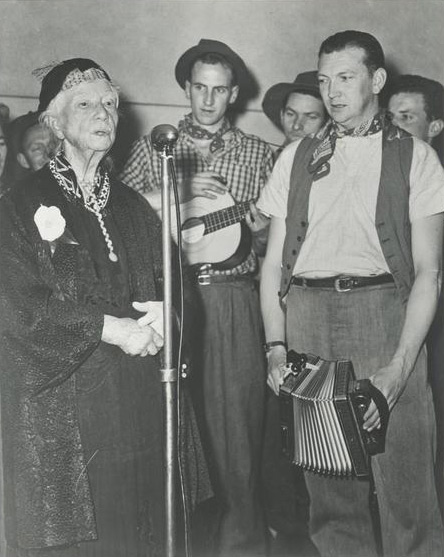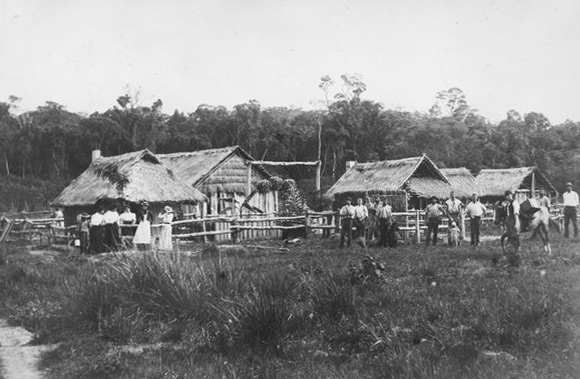Mary Gilmore
Mary Gilmore was born Mary Jean Cameron on 16 August 1865, at Mona Vale, near Goulburn, New South Wales. The eldest child of Donald and Mary Ann Cameron, ‘Jeannie’ (as she was known by her family) was less than a year old when the family sold the property and moved west to the prospering region of Wagga Wagga, on the Murrumbidgee River.
Up until the age of eight, Mary lived a nomadic life with her family, moving from one country station to another as her father’s work demanded. During a short period of stability between stations, Mary attended the Brucedale school, near Wagga Wagga, where she discovered the joy of writing. She later recalled,
I learned to compose sentences and write. Instead of going out to play in the dinner hour I would stay in school writing stories and descriptions of things filling both sides of my slate as fast as I could go… in an absolute fury of composition.
In the brief time that Gilmore was a student, she attended a number of schools in the area, including the new Wagga Wagga Public School, where she spent just over two years. At the young age of twelve, Mary moved to Cootamundra where she began working alongside her uncle as an unpaid school assistant.
After passing her teaching examinations at the age of sixteen, Gilmore entered the Wagga Wagga Public School as a pupil-teacher. She completed her contract in Wagga Wagga before undertaking a number of school placements in regional New South Wales. On her return, she requested a transfer to Sydney and in 1890 began teaching at Neutral Bay Public School.
To avoid overstepping the boundaries of her teaching contract, Mary wrote under the pen names Em Jaycey, Sister Jaycey and Rudione Calvert.
In Sydney, the contentious issues surrounding workers' rights ignited Gilmore’s interest in politics and social reform. She was a staunch supporter of the union strikes and became the first female member of the Australian Workers' Union. During this time, Gilmore also established her reputation as a fiery, radical writer in the Bulletin and New Australia journals.
William Lane’s New Australia movement was based on the socialist ideals of common values over common wealth and required adherence to a strict set of rules.
In 1895, Gilmore resigned from teaching and set sail on a twenty-two day journey to join William Lane's New Australia movement in Paraguay, South America. At the Cosme settlement, she met ‘the manly’ Victorian shearer, William Gilmore and the couple married the following year.
Mary and William’s first and only child, William, was born on 28 August 1898. With growing fears for her own health and that of her son, the family left the struggling utopian settlement just under a year later, making several stops in South America and England before returning to Sydney in 1902.
In Australia, Gilmore threw herself into her writing. As editor of the women’s page of the Australian Worker from 1908-1931, she championed the causes of a wide range of social and economic reforms, including votes for women, invalid pensions, Aboriginal welfare and improved treatment for returned servicemen and the underprivileged.
In 1910, Gilmore published her first collection of poetry, Marri'd, and other Verses, which contained no less than 147 poems, including many written at Cosme. The title verse, Marri’d, was originally published as ‘The Housewife’ in the Cosme Monthly and reflects upon her new experience of marriage.
It's singin' in an' out,
An' feelin' full of grace;
Here 'n' there, up an' down,
An' round about th' place.
Read Marri’d and other Verses online
With the outbreak of war in 1914, Mary used her writing as a way of grappling with the appalling reality unfolding around her. Her second volume of poetry, The Passionate Heart, was released in 1918 and opened with the rallying inscription ‘For Love of Them! For Love of Them!’, referring to the diggers on the distant battlefields.
In 1930, Gilmore published The Wild Swan, a book of verse decrying white settlers’ ravaging of the land and contempt for Aboriginal culture. Under the Wilgas (1932) and subsequent works expanded further on this theme. In 1937, she became the first person appointed Dame of the British Empire for services to writing.
The Dame on the $10 note
Dobell’s portrait appears in Max Robinson’s design of the $10 note featuring Mary Gilmore.
Look closely at the $10 note. What do the images in the background represent?
In 1954, as Gilmore approached her ninetieth year, she released her final volume of poetry, Fourteen Men. Two years later, she became the face of controversy when her portrait by William Dobell was selected as a finalist in the 1957 Archibald Prize. Once again the artist was scrutinised for his unconventional style, but Gilmore defended the painting, saying he had captured something of her ancestry in the portrait.
Mary Gilmore passed away on 3 December 1962, aged 97, and was honoured with a State funeral in Sydney. This was the first for an Australian writer since the death of Henry Lawson forty years earlier.



